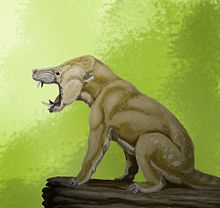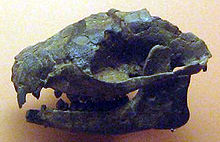- Condylarth
-
Condylarths
Temporal range: Late Cretaceous - Oligocene, 65.5–23 Ma
Arctocyon, a plantigrade condylarth Scientific classification Kingdom: Animalia Phylum: Chordata Class: Mammalia Infraclass: Eutheria Superorder: Laurasiatheria? Order: †Condylarthra
Cope, 1881Families - †Arctocyonidae
- †Periptychidae
- †Hyopsodontidae
- †Meniscotheriidae
- †Mioclaenidae
- †Phenacodontidae
- †Didolodontidae
- †Sparnotheriodontidae?
Condylarthra is an order of extinct placental mammals known primarily from the Paleocene and Eocene epochs.[1] Condylarths are among the most characteristic Paleocene mammals and they illustrate the evolutionary level of the Paleocene mammal fauna.
When compared to today's mammals, condylarths are relatively unspecialized placental mammals. However, in comparison to their insectivorous ancestors, members of the Condylarthra show the first signs of specializing to become omnivores or even herbivores.
Contents
Evolutionary history
Since larger land-bound herbivores were absent since the extinction of the dinosaurs, the shift in diet from insectivorous to more herbivorous trophic categories triggered the tremendous evolutionary radiation of the condylarths that we can observe throughout the Paleocene, resulting in the different groups of ungulates (or "hoofed mammals") that form the dominant herbivores in most Cenozoic animal communities on land, except on the island continent of Australia.
Here, the term Ungulata refers to a subgroup of placental mammals that are descendants of a common ancestor (i.e. homologous to), the most primitive condylarth. Among recent mammals, Paenungulata (hyraxes, elephants, and sea cows), Perissodactyla (horses, rhinoceroses, and tapirs), Artiodactyla (pigs, antelope, camels, hippos, and their relatives), Cetacea (whales), and Tubulidentata (aardvarks) are traditionally regarded as members of the Ungulata.[1][2] Besides these, several extinct animals also belong to this group, especially the endemic South American orders of ungulates (Meridiungulata). Although many ungulates have hoofs, this feature does not define the Ungulata. Some condylarths indeed have small hoofs on their feet, but the most primitive forms are clawed.
Recent molecular and DNA research has reorganised the picture of mammalian evolution. Paenungulates and tubulidentates are seen as Afrotherians, and no longer seen as closely related to the Laurasiatherian perissodactyls, artiodactyls, and cetaceans,[3][4] implying that hooves were acquired independently (i.e. were analogous) by at least two different mammalian lineages, once in the Afrotheria and once in the Laurasiatheria. This raises the possibility that Condylarthra itself is polyphyletic: the several condylarth groups may not be related to each other at all. Indeed condylarths are increasingly regarded as a 'wastebasket' taxon,[5] though true relationships remain in many cases unresolved.
In addition to meridiungulates and living ungulates, a condylarthran ancestry has been proposed for several other extinct groups of mammals, including Mesonychia[6] and Dinocerata.[7]
Taxonomy
- Family Arctocyonidae
- Family Periptychidae
- Family Hyopsodontidae
- Subfamily Tricuspiodontinae
- Genus Litomylus
- Genus Paratricuspiodon
- Genus Tricuspiodon
- Genus Aletodon
- Genus Decoredon
- Genus Dipavali
- Genus Dorraletes
- Genus Haplaletes
- Genus Haplomylus
- Genus Hyopsodus
- Genus Louisina
- Genus Microhyus
- Genus Midiagnus
- Genus Oxyprimus
- Genus Palasiodon
- Genus Paschatherium
- Genus Utemylus
- Genus Yuodon
- Subfamily Tricuspiodontinae
- Family Mioclaenidae
- Family Phenacodontidae
- Subfamily Meniscotheriinae
- Genus Ectocion
- Genus Meniscotherium
- Genus Orthaspidotherium
- Genus Pleuraspidotherium
- Genus Almogaver
- Genus Copecion
- Genus Eodesmatodon
- Genus Phenacodus
- Subfamily Meniscotheriinae
- Family Didolodontidae
- Family Sparnotheriodontidae?
- Genus Tingamarra?
- Genus Protungulatum
- Genus Kharmerungulatum
See also
References
- ^ a b McKenna, M. C, and S. K. Bell (1997). Classification of Mammals Above the Species Level. Columbia University Press. ISBN 023111012X.
- ^ Novacek, M.J. (1986). "The skull of leptictid insectivorans and the higher-level classification of eutherian mammals". Bulletin of the American Museum of Natural History 183 (1): 1–111. hdl:2246/1628.
- ^ Madsen, O., M. Scally, C.J. Douady, D. Kao, R.W. DeBry, R. Adkins, H.M. Amrine, M.J. Stanhope, W.W. de Jong, and M.S. Springer (2001). "Parallel adaptive radiations in two major clades of placental mammals". Nature 409 (6820): 610–614. doi:10.1038/35054544. PMID 11214318.
- ^ Murphy, W.J., E. Eizirik, S.J. O'Brien, O. Madsen, M. Scally, C.J. Douady, E.C. Teeling, O.A. Ryder, M. J. Stanhope, W.W. de Jong, and M.S. Springer (2001). "Resolution of the early placental mammal radiation using Bayesian phylogenetics". Science 294 (5550): 2348–2351. doi:10.1126/science.1067179. PMID 11743200.
- ^ Janis, C.M. (1993). "TERTIARY MAMMAL EVOLUTION IN THE CONTEXT OF CHANGING CLIMATES, VEGETATION,AND TECTONIC EVENTS". Annual Review of Ecology and Systematics 24: 467–500. doi:10.1146/annurev.es.24.110193.002343. http://linux02.lib.cam.ac.uk:2055/doi/pdf/10.1146/annurev.es.24.110193.002343.
- ^ Van Valen, L.M. (1966). "Deltatheridia, a new order of mammals". Bulletin of the American Museum of Natural History 132 (1): 1–126. hdl:2246/1126.
- ^ Van Valen, L.M. (1988). "Paleocene dinosaurs or Cretaceous ungulates in South America?". Evolutionary Monographs 10: 1–79.
Categories:- Mammals
- Paleocene mammals
- Paleocene extinctions
- Condylarths
Wikimedia Foundation. 2010.

